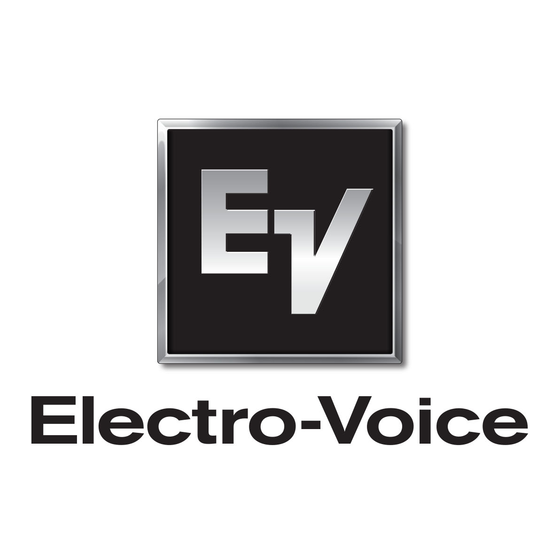Table of Contents
Advertisement
Quick Links
Advertisement
Table of Contents

Summary of Contents for Electro-Voice UCC 1
- Page 1 Owner’s Manual UCC 1 USB-CAN CONVERTER...
-
Page 2: Table Of Contents
Contents Description... 17 Controls and Connections... 18 Installation ... 19 Unpacking... 19 Rack-Mounting... 19 Initial Operation... 20 PC Connection and CAN Driver Installation ... 20 Installing IRIS... 20 CAN-Bus Connection... 20 ISOLATED / GROUNDED Switch ... 22 Monitor Bus... 23 Technical Information ... -
Page 3: Controls And Connections
2. Controls and Connections 1. USB connector This connector is for the connection to the USB-port on your PC. The interface complies with the USB 1.1 specifications and offers data transfer as well as operation voltage supply for the UCC1. 2. -
Page 4: Installation
3. Installation 3.1 Unpacking The UCC1 package includes the following parts: 1 UCC1 USB-CAN CONVERTER 1 Front panel 19“, 1HU 2 CAN-TERM 120 Ω CAN-bus terminator-plug 4 Rubber feet 1 USB cable 1 Owner’s manual Upon receiving your UCC1, please inspect the contents of the package for loss or damage. If any of the here listed parts are missing or damaged, please immediately contact your distributor or a TELEX / EVI Audio service center. -
Page 5: Initial Operation
4. Initial Operation Follow these four steps when operating the UCC1 for the first time: Connect the UCC1 to the PC and install the CAN drivers, install the IRIS-software, connect the desired appliances to the CAN-bus, and set the ISOLATED / GROUNDED switch accordingly. 4.1 PC Connection and CAN Driver Installation Use the supplied USB cable for connecting the UCC1 to your PC’s or Notebook’s USB-socket. - Page 6 Fig 4: System set-up with 5 amps and a single UCC1 / PC being the first unit on the bus Terminators at the UCC1 (first unit) and at the amp No.5 (last unit on the bus) Fig 5: System set-up with 2 racks and a single UCC1 / PC in the middle Terminators at amp No.
-
Page 7: Isolated / Grounded Switch
Fig 6: System with several racks and several UCC1 / PCs UCC1 anywhere on the CAN-bus Terminators at amp No. 10 (first unit) and amp No. 16 (last unit on the bus) 4.4 ISOLATED / GROUNDED Switch Principally, the CAN-bus is galvanically isolated from any other participant on the bus, i.e. from all P- Series Remote amps and from the UCC1 USB-CAN Converter as well, a circumstance which as a matter of fact results in effective elimination of ground-loop interference noise. -
Page 8: Monitor Bus
The ISOLATED / GROUNDED switch located on the UCC1’s front panel allows bridging this galvanic isolation putting the CAN-bus of the UCC1 on circuitry ground potential. The CAN-bus should normally be referenced to the ground potential at one single point in the network. -
Page 9: The Can-Bus Standard
The pin-assignment of CAN-bus connectors is shown in figure 8. Fig. 8: CAN BUS IN / OUT connector pin-assignment 6.2 The CAN-Bus Standard Developed in the 1980’s, the CAN-bus norm had been established in the 1990’s by the International Standardization Organization (ISO) as a worldwide standard. Since then, CAN has become very popular especially in automotive and industrial applications. -
Page 10: Maximum Cable Length On The Can-Bus
Baud Rate Bus Length 500 kbit/s 100 m 250 kbit/s 250 m 125 kbit/s 500 m 62,5 kbit/s 1000 m 20 kbit/s 2500 m 10 kbit/s 5000 m The use of repeaters is generally recommended when a network’s bus length exceeds 1000 m. 6.3 Maximum Cable Length on the CAN-Bus According to the ISO 11898-2 standard, CAN-bus data transfer cabling has to be carried out using Twisted-Pair cables with or without shielding providing a characteristic impedance of 120 Ω. - Page 11 Additionally, the length of any stub lines for participants that are not directly connected to the CAN- bus needs to be kept in mind. For data transfer rates of up to 125 kbit/s the length of a single stub cable should not exceed 2 m.
-
Page 12: Specifications
7. Specifications CAN BUS: Sockets Baud Rate Number of Nodes Data Format Cable Length USB: Socket Standard Cable Length MONITOR: Socket Output Voltage (nominal) Max. Output Voltage Output Impedance Min. Load Impedance Power Supply Power Consumption Operation Temperature Range Certified Dimensions with 19“...



Need help?
Do you have a question about the UCC 1 and is the answer not in the manual?
Questions and answers